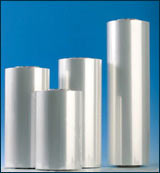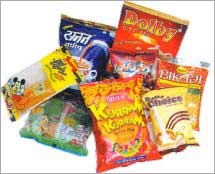Flexible Package Wrap
People use shrink wrap all the time without understanding that you can put
flexible wrap around a package in many different ways and that different
wraps have different properties. This wrapping process applies to plastic
film or paper, cellophane, waxed paper as alternate materials that are used
to wrap products.
The critical concerns when wrapping a package vary. In some cases, it is a
barrier seal on the product to preserve freshness. In other cases it is
simply to insure that the product has not been tampered with. Other reasons
to wrap include cosmetic appearance - critical to catching the eye of the
consumer- or bundling to keep a collection of products together. In some
cases the film carries the product message; in others it is an enhancement
to the message on the packaging beneath. Some wrapping processes allow for
some air circulation; others permit no air. There are as many reasons to
wrap as there are products requiring wrapping.
Shrink Wrapping Procees

Shrink
wrapping is a process that uses relatively soft polyolefin film in which a
loose sheath of film is created around the product, sometimes sealed on one
or two sides. The loosely sheathed product passes through a heat tunnel,
which shrinks the film to the dimensions of the product. The result is a
very tight wrap, conforming to the product shape, often with a ridge of
plastic around the perimeter of the product or gaps in film on the ends.
Shrink wraps are typically stronger than overwraps and the machines are
inherently very flexible. The downside is that shrink wraps can be less
attractive than overwraps.
Shrink wrap process is a great solution when the product is irregularly
shaped or there is a low volume of any one size package. Operational costs
are typically higher because of film cost, film waste and energy consumption
in the shrinking process. Products must be heat tolerant due to the heat
tunnel required to make the film fit the package. You usually cannot use
printed film, as the film often distorts as it shrinks.
Note: "stretch" and "shrink" obviously don't mean the
same thing. Stretch wrappers, a popular choice for wrapping pallet loads of
products, achieve tight wraps by expanding the stretch
film-rubber-band-like-before enveloping the product and letting the film
return to its original size. Both use polyethylene films.
Overwrapping Process

Overwrapping
is a process in which a box-shaped carton, tray, bundle, etc. is wrapped and
sealed. The only requirement for the package shape is that it have flat
sides to be sealed. It is sometimes called diamond-fold wrapping,
tuck-andfold wrapping, gift-box wrapping, cigarette wrapping and bundle
wrapping. Tear tape can be used as an easy-open feature.
The end result looks like a "gift wrap," with one long seam
located either on the bottom or side of the package and each end of the
package neatly "tucked, folded and sealed."
You can use a variety of relatively stiff, single- or multi-ply web
materials including clear, printed and/or metallized polypropylene (PP),
cellophane, paper, glassine, waxed paper, aluminum foil or metallized
paper/BOPP (biaxially oriented polypropylene). You cannot overwrap with soft
[polyethylenebased] films. Such films are too soft and have too much "give"
to be used in overwrapping.
While you need heat to seal the film or set the glue (with paper), your
heat needs are limited to the spots needing sealing.
Overwrapping machines are built in elevator, in-line, turret or rotary
styles.
Examples of overwrapped products include cigarettes, Easter "PEEPS"
candies, CDs/DVDs, some frozen food cartons, perfume, and boxes of tea.
Bundling using overwrappers is increasingly popular and can be done
provided the underlying package or its container has the strength to provide
support to the bundled package. For instance, overwrappers have been used to
bundle 6 sleeves of golf balls because the golf balls and their individual
sleeves can support the weight of the others bundles with them. This is also
done with boxes of candy. It would be more of challenge if the plan was to
stack trays.
 Flow
Wrapping Process
Flow
Wrapping Process
Synonyms for flow-wrap include fin-seal wrapping, crimp-seal wrapping,
horizontal bagging and pillow-pouch wrapping. Flow wrapping is a
horizontalmotion process in which product of any shape (but usually of even
depth) is wrapped in clear or printed polypropylene film. The end result is
a flexible package with a non-lap type seal on the bottom and crimped end
seals.
Good flow-wrappers get the film tightly around the product to minimize
product shift within the package and minimize the "tails" on the
product, as they make case-packing more difficult. Flowwrapping is used
where a high speed application is called for with a complete barrier seal.
For example, mass market candy bars.
Both the process and films in flow wrapping are quite different from
overwrapping. Flow wrap BOPP films, for example, need only to seal to
themselves. Overwrap films need to seal to themselves and the other side of
the film. There are zillions of products that are flow-wrapped. Think wipes,
tissues, vending machine candy bars, etc.
Diefold Process
This process-not widely used anymore-achieves an overwrap on a soft, nonbox
shaped product by enveloping it (often after it is placed on a card or
Uboard) in film and sealing the bottom. The film forms either a box or
circular shape around the product via a "die-box" in the machine's
elevator section. Limited application of heat (only to the bottom seal)
gives the product a tuckand- fold appearance that doesn't need side sealers
and won't allow the product to be crushed by the machine or melted by its
heat.
Flow-wrap has largely replaced diefold. For example, Reese's Peanut Butter
Cups once were diefold-wrapped with two cups seated on a chocolate-colored
Uboard in cohesive film (which requires no heat for sealing). The process is
still used for some Reese's Peanut Butter Cup SKUs. Also, "homemade"
cookies whose manufacturers are going for the "baked-like-grandma's"
look still use the diefold wrapping process.
Candy bar or Gum wrap
This specialized wrap is achieved with a turret style machine going at high
speed and causing both metallized foil and paper to conform to the package.
Like Diefold wrap, the tuck and fold are underneath the package.


 Shrink
wrapping is a process that uses relatively soft polyolefin film in which a
loose sheath of film is created around the product, sometimes sealed on one
or two sides. The loosely sheathed product passes through a heat tunnel,
which shrinks the film to the dimensions of the product. The result is a
very tight wrap, conforming to the product shape, often with a ridge of
plastic around the perimeter of the product or gaps in film on the ends.
Shrink wraps are typically stronger than overwraps and the machines are
inherently very flexible. The downside is that shrink wraps can be less
attractive than overwraps.
Shrink
wrapping is a process that uses relatively soft polyolefin film in which a
loose sheath of film is created around the product, sometimes sealed on one
or two sides. The loosely sheathed product passes through a heat tunnel,
which shrinks the film to the dimensions of the product. The result is a
very tight wrap, conforming to the product shape, often with a ridge of
plastic around the perimeter of the product or gaps in film on the ends.
Shrink wraps are typically stronger than overwraps and the machines are
inherently very flexible. The downside is that shrink wraps can be less
attractive than overwraps.  Overwrapping
is a process in which a box-shaped carton, tray, bundle, etc. is wrapped and
sealed. The only requirement for the package shape is that it have flat
sides to be sealed. It is sometimes called diamond-fold wrapping,
tuck-andfold wrapping, gift-box wrapping, cigarette wrapping and bundle
wrapping. Tear tape can be used as an easy-open feature.
Overwrapping
is a process in which a box-shaped carton, tray, bundle, etc. is wrapped and
sealed. The only requirement for the package shape is that it have flat
sides to be sealed. It is sometimes called diamond-fold wrapping,
tuck-andfold wrapping, gift-box wrapping, cigarette wrapping and bundle
wrapping. Tear tape can be used as an easy-open feature.  Flow
Wrapping Process
Flow
Wrapping Process